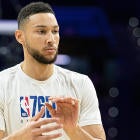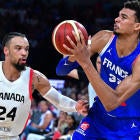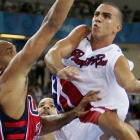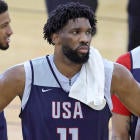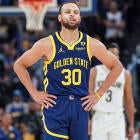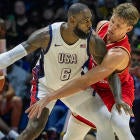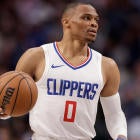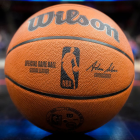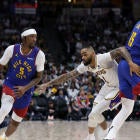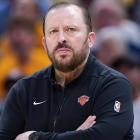The Ben Simmons conversation is fraught. He won't shoot jumpers, and his aversion to the 3-point line has been dissected from every angle. If you can look past that, though, you'll see the significant strides he has made since winning Rookie of the Year in 2018. At 23, Simmons has evolved into one of the best all-around defenders in the NBA, and there is growing evidence that he can be effective off the ball as a roller and cutter.
In a recent profile by ESPN's Jackie MacMullan, Philadelphia 76ers coach Brett Brown said he had talked to Simmons about his shooting after the All-Star break, just before Simmons' back injury. The discussion left Brown feeling optimistic about where things were going. Now, however, the Sixers are in limbo along with the rest of the world, and it's unclear what the team will look like the next time Simmons takes the court.
Beyond becoming a confident shooter, what are the next steps in Simmons' development? What is his ideal role, in Philadelphia or otherwise? CBS Sports' James Herbert, Michael Kaskey-Blomain and Brad Botkin discuss:
James Herbert: My gripe with most Simmons debates is that there is often no distinction made between what is best for Simmons and what is best for the Sixers. Simmons will be a perennial All-Star if he changes nothing about his game, and his reputation would be different if he hadn't spent his entire professional career on this team, playing this role, with these teammates.
But the reality is that he is in Philadelphia and he sees himself as a point guard. What's more likely, Simmons getting comfortable shooting or Simmons letting someone else become the Sixers' primary ballhandler? Would we even be having this conversation if Markelle Fultz's shot hadn't disappeared?
Michael Kaskey-Blomain: The Fultz thing is extremely interesting. It's easy to forget now given all that has happened, but Fultz was drafted by Philadelphia specifically to fit alongside Simmons as a combo guard that could both knock down shots while playing off-ball and initiate the offense. The idea was that Fultz could spot up off of Simmons in transition, where Simmons is lethal, and sometimes take the ball out of Simmons' hands in the halfcourt, where he is less effective due to his inability to space the floor.
Things obviously didn't work out with Fultz in Philly, but the rationale was sound. Short of Simmons suddenly shooting willingly, pairing him with another such combo guard is the best option for the Sixers to maximize their talent. This would allow Simmons to continue to do damage in transition, plus be effective in the halfcourt without the ball. He has averaged two offensive rebounds per game over the course of his career, and he has shown an ability to work as the roll man in pick-and-roll scenarios, something that Brown experimented with in small doses during the 2019-20 season.
In the above plays the SIxers used Josh Richardson as the primary ballhandler and Simmons as the screener, and both times it resulted in an easy basket for Simmons. While it certainly wouldn't be this easy every time, Simmons' nearly unlimited athleticism and high basketball IQ makes him an ideal roller. It's a wrinkle that the Sixers should explore more.
Whenever play resumes, it would be interesting to see Simmons paired next to Shake Milton, who really started to emerge as a legitimate guard option for the SIxers in Simmons' absence before the season was suspended. Milton can knock down shots off the catch and also initiate offense and set others up, and he could potentially fill the role that Fultz was supposed to for Philadelphia.
Brad Botkin: I'm with you guys on Fultz. He was supposed to be the player that slid Simmons into his optimal role, and had that happened, we likely would've spent the last few years celebrating all the things Simmons does rather than obsessing over the one thing he doesn't.
But plans don't always work out, circumstances change, and Simmons and the Sixers are suddenly stuck in a tough spot. As the roster stands, finding someone to run elite halfcourt offense is going to continue to be the difference between this team being dangerous for its talent and a legit threat for the way in which that talent fits together.
And Simmons, like it or not, is at the core of that problem. To me, it's a no-brainer. He should be playing the four spot, effectively a point-forward as something of a supercharged Draymond Green prototype who rebounds and pushes on the break then cedes control in the halfcourt, where he morphs into an instinctual screener, cutter, roller and lob threat.
Until Philly gets that Chris Paul-type point guard or someone who can do what Fultz was supposed to do, the position Simmons plays is where this conversation starts and ends for me. He wants to be a point guard, to whatever extent that positional distinction still exists. He has to let that desire to be a central part of the halfcourt offense go and do what's best for the team, and really, what's best for him, too.
Herbert: Simmons is one of the players that makes me wish the NBA would do away with antiquated positional designations entirely. But as long as people treat traditional positions as relevant and real, they will have real consequences.
The issue is twofold. First, yes, it is a problem that Simmons has long seemed fixated on being the "point guard." Before he even played an NBA game, Simmons pushed back on the notion that he would be a Lamar Odom or Toni Kukoc type, facilitating offense while remaining a nominal frontcourt player. "Not point-forward," Simmons said in a 2017 Sports Illustrated story by Andrew Sharp. "Point guard. You see Kyrie Irving starting at point? I'm starting at point."
The other problem, though, is that our own fixation on Simmons' position obscures what is actually plaguing Philadelphia. I have loathed watching the Sixers' halfcourt offense this year, but we have to remember how effective they've been offensively with Simmons running the show for most of his career.
In Simmons' rookie year, the Sixers' killer starting lineup -- Simmons, JJ Redick, Robert Covington, Dario Saric and Joel Embiid -- outscored opponents by 21.7 points per possession, according to Cleaning The Glass, and scored 102.9 points per halfcourt play. (The Golden State Warriors' league-best halfcourt offense scored 101.5 points per play that season.) The next year, their starters with Jimmy Butler and Tobias Harris in place of Covington and Saric scored a scorching 112.2 points per halfcourt play (in a relatively small sample). Replacing Redick and Butler with Richardson and Al Horford has been disastrous, though: Philadelphia's starting five has scored just 91.9 points per halfcourt play this season.
While the bully-ball experiment has been undeniably ugly, there should be no doubt that Simmons can quarterback an elite offense, at least in the regular season. Simmons' detractors, however, can point to the way the Sixers' offense sputtered against the Boston Celtics in the 2018 playoffs, and the mere fact that management felt it necessary to trade for Butler in the first place. As much as I hate most old-school platitudes about the game, every contender needs a creator who can get his own shot late in the clock and against elite playoff defense. The Sixers wouldn't have made it to Game 7 in Toronto a year ago if Brown hadn't given Butler the ball and told Simmons to essentially play like Draymond.
Barring a miracle, I don't see Philadelphia finding a way to get another perimeter star of Butler's caliber. It could, however, potentially find a shooter who can come off pindowns and run dribble-handoffs the way Redick did, and it could either trade Horford or limit the minutes in which he plays next to both Simmons and Embiid. If Richardson, Harris and Milton are as good as it's going to get in terms of secondary playmaking, is there anything -- aside from showing up with a pull-up 3 in his arsenal -- that Simmons can do to become a better lead guy?
Kaskey-Blomain: Given how long he's been in the spotlight, it's easy to forget that Simmons is still very young. At 23, he was in the middle of just his third season when the '19-20 campaign was suspended indefinitely. While top overall picks typically join a team with limited expectations, which affords them an opportunity to learn on the go, Simmons joined a Sixers squad that had high hopes right from the jump, and their early success during his rookie season only amplified expectations for both Simmons and the Sixers moving forward.
"There was never any house money with Ben," Brown said in the recent ESPN story.
All of this is to say that there's still plenty of room -- and time -- for improvement for Simmons. LeBron James was far from the polished and complete player that he is today when he was 23. Instead, he focused on and improved his various weaknesses over time -- something Simmons will have an opportunity to do. If Simmons hasn't developed as a shooter or gotten better at playing off of the ball by the time he's 25 or 26, there will be legitimate cause for concern. But for now, concerns about his game overall are a bit overblown in my eyes.
Botkin: James' point about Simmons being capable, in fact highly capable, of spearheading a potent offensive attack is important. I couldn't agree more. That 2016-17 season that James referenced, the Sixers were looking like a fringe Finals threat the way they rolled down the stretch of the season and through their first-round playoff win over Miami. Simmons with shooters all around him was terrifying.
That's why I was careful to say "as the roster stands" in my initial remarks. Philadelphia GM Elton Brand has painted the Sixers into a corner with no shooting and the crippling Harris and Horford contracts on the books for the foreseeable future.
The blueprint for a successful offense built around Simmons is, really, pretty simple. Put shooters everywhere. Do it like the Bucks are doing with Giannis Antetokounmpo. And again, the Sixers had that in place. At one time or another they employed Saric, Covington, Redick, Ersan Ilyasova, Marco Belinelli and Landry Shamet, and they looked lethal.
But then they got antsy and went after big names, dumping Saric and Covington for Butler before wildly overtrading for Harris just for the right to then wildly overpay him. Instead of going after Horford -- who never really made sense next to Embiid, and $109 million is a lot of coin for some big-man security during non-Embiid minutes -- last summer, they could have gotten Malcolm Brogdon for $25 million less. They could have gotten Bojan Bogdanovic for $35 million less. Heck, they could've just hung onto Redick.
So again, being that the roster is what it is, and the Sixers' financial flexibility to significantly change their predicament is virtually nonexistent, Simmons, unfortunately, now has to be the one to change. They just don't have the shooting or reliable playmaking to compensate for his one glaring weakness. It shouldn't have been that way.
Philly should have prioritized shooting, either by keeping the threats it had or by pursuing guys like Brogdon or Bogdanovic in the summer. Shooting hides Simmons' weakness and accentuates Embiid's strength, giving him room to operate in the post. It's that simple, and the Sixers complicated it. And now Simmons looks like a problem when in fact he should be talked about as one of the top five assets in the league.
Herbert: In different ways, you're both saying that the stakes feel incredibly high, even if they shouldn't. The rest of Brown's quote to MacMullan is important here: "If Ben was with a team in his first few years that no one gives a rat's ass about, and they were figuring out who the keepers were on their roster, he would have come in cranking 3s. I'm sure of it."
At this point, I don't even think Philadelphia needs Simmons to crank 3s. If he takes the occasional spot-up 3 and some off-the-dribble jumpers from inside the line, that would be a start. Continued improvement from the free throw line would help, too. Baby steps.









